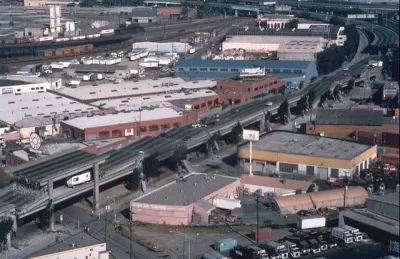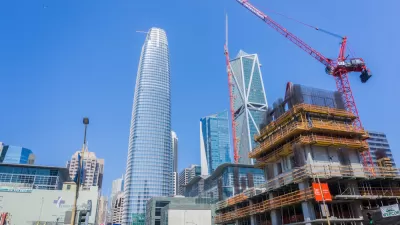As the death toll from Mexico's 7.1 magnitude earthquake on Sept. 19 climbs above 300, the San Francisco Chronicle investigates how well prepared the Bay Area is for an earthquake of comparable magnitude. Not very well.

The day after Mexico City was hit with a 7.1 magnitude earthquake, Planetizen looked at the city of Los Angeles' "mandatory retrofit programs," which target pre-1978 wood-frame soft-story buildings and brittle concrete buildings.
With few exceptions, Bay Area cities are not as well prepared, somewhat similar to what Planetizen observed after a 6.0 earthquake shook Napa County on Aug. 24, 2014, resulting in over $1 billion in damage.
Ahead of the pack of the 101 cities and towns in the 9-county Bay Area is San Francisco which passed a law in 2013 requiring mandatory retrofits of wood-framed, multi-family buildings built before 1978 with a soft-story condition.
“That’s a visionary change and San Francisco was way out in front of other jurisdictions,” said geophysicist Ken Hudnut, science adviser for risk reduction for the U.S. Geological Survey, report John Wildermuth and J.K. Dineen “But in many cases, a lot of old stuff is grandfathered in and not all jurisdictions are as forward thinking as San Francisco.”
According to the Bay Area's council of governments, the Association of Bay Area Governments (ABAG), only two other cities have mandatory wooden soft-story retrofit programs: Berkeley and Fremont. However, the amount of vulnerable buildings is incomparable, with San Francisco having 6,700 and Fremont only 22.
Wildermuth and Dineen write that "a 7.1 earthquake in the Bay Area could even be more deadly than the Mexico City temblor." In addition to soft-story wood buildings, "older concrete buildings -- which in San Francisco tend to be commercial buildings — are particularly vulnerable." [See the three types of buildings most vulnerable].
Unlike Los Angeles, the San Francisco retrofit program doesn't include non-ductile concrete buildings. ["'Ductile' means flexible, while 'reinforced concrete' refers to concrete embedded with material such as steel mesh and rebar," according to the Live Science website.
Finally, Wildermuth and Dineen also report extensively on what went wrong in Mexico City.
"Non-engineered construction is common in Mexico,” said Mario Ordaz and Roberto Meli, two engineering professors at UNAM, Mexico’s premier university, in their paper presented at a 2004 Vancouver, B.C., conference on earthquake engineering.
“As a consequence, a large percentage of the building stock (and in some parts of the country, the vast majority) is built without construction permits, without compliance with codes and without the participation of qualified professionals.”
Behzad Fatahi, an associate professor of geo-technical and earthquake engineering at the University of Technology Sydney, said it best in a CNN interview on Sept. 20:
Earthquakes do not kill; but inadequately designed and poorly constructed buildings, infrastructure and lifeline systems can.
The best way to save lives is to design structures that can withstand earthquakes and retrofit old buildings to fit the code.
FULL STORY: How ready will Bay Area be for next big quake?

Alabama: Trump Terminates Settlements for Black Communities Harmed By Raw Sewage
Trump deemed the landmark civil rights agreement “illegal DEI and environmental justice policy.”

Study: Maui’s Plan to Convert Vacation Rentals to Long-Term Housing Could Cause Nearly $1 Billion Economic Loss
The plan would reduce visitor accommodation by 25% resulting in 1,900 jobs lost.

Why Should We Subsidize Public Transportation?
Many public transit agencies face financial stress due to rising costs, declining fare revenue, and declining subsidies. Transit advocates must provide a strong business case for increasing public transit funding.

Paris Bike Boom Leads to Steep Drop in Air Pollution
The French city’s air quality has improved dramatically in the past 20 years, coinciding with a growth in cycling.

Why Housing Costs More to Build in California Than in Texas
Hard costs like labor and materials combined with ‘soft’ costs such as permitting make building in the San Francisco Bay Area almost three times as costly as in Texas cities.

San Diego County Sees a Rise in Urban Coyotes
San Diego County experiences a rise in urban coyotes, as sightings become prevalent throughout its urban neighbourhoods and surrounding areas.
Urban Design for Planners 1: Software Tools
This six-course series explores essential urban design concepts using open source software and equips planners with the tools they need to participate fully in the urban design process.
Planning for Universal Design
Learn the tools for implementing Universal Design in planning regulations.
Smith Gee Studio
Alamo Area Metropolitan Planning Organization
City of Santa Clarita
Institute for Housing and Urban Development Studies (IHS)
City of Grandview
Harvard GSD Executive Education
Toledo-Lucas County Plan Commissions
Salt Lake City
NYU Wagner Graduate School of Public Service



























